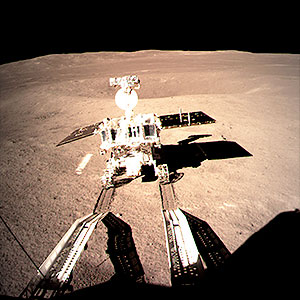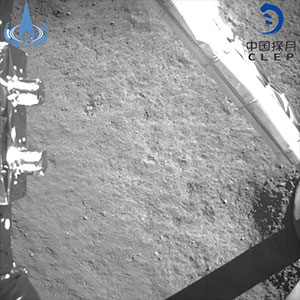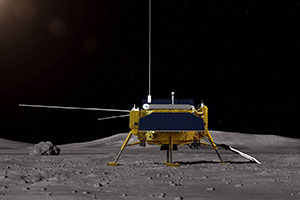January 3, 2019 — A Chinese robotic probe carrying a small, multi-wheeled rover has become the first spacecraft in history to land on the far side of the moon.
China's Chang'e 4 lander touched down on the side of the moon that permanently faces away from Earth. The landing in Von Kármán crater within the moon's South Pole-Aitken basin was achieved on Wednesday (Jan. 2) at 9:26 p.m. EST (0226 GMT or 10:26 a.m. Beijing time on Jan. 3), according to the China National Space Administration (CNSA).
"The mission realized the first soft landing of a spacecraft and the relay of communications from the far side of the moon, opening a new chapter in human lunar exploration," stated CNSA in a release.
Just over an hour after touching down, the Chang'e 4 lander transmitted the first image from its vantage point on the surface, showing a small crater in the direction that the Change'4 rover was soon to be deployed to begin its planned traverse.
Launched on a Chinese Long March rocket from the Xichang Satellite Launch Center in southwest China on Dec. 7, 2018, the Chang'e 4 probe arrived in lunar orbit five days later. It then circled the moon for three weeks while flight controllers carried out tests of the spacecraft's systems and waited for the lighting conditions on the far side to support an autonomous landing.
The spacecraft's descent to the lunar surface began Wednesday from a distance of about 9 miles (15 kilometers) above the moon. After firing its engine to gradually lower to 330 feet (100 meters), the lander briefly paused its approach and hovered while it scanned the area below for a suitable flat surface to touch down.
The entire descent took 11 minutes to complete.
Following the landing and making contact with Earth, flight controllers commanded the lander to deploy its solar panel wing and directional antenna, followed hours later by the signal to deploy the rover. The wheeled vehicle made first contact with the surface at 9:22 a.m. EST (1422 GMT; 10:22 p.m Beijing time) on Thursday.
Originally built as a backup to China's Chang'e 3 probe and Yutu ("Jade Rabbit") rover that landed on the moon's Sea of Rains (Mare Imbrium) in December 2013, the Chang'e 4 lander and its "Yutu 2" rover were modified to handle the rougher terrain anticipated at the far side landing site and the need to relay data through the Queqiao ("Magpie Bridge") communications satellite that China deployed into a halo orbit around the second Lagrangian (L2) point of the Earth-Moon system in May 2018.
Now on the moon, the Chang'e 4 lander and rover will use their eight on board science instruments, payloads and cameras to accomplish the mission's research objectives, including a low-frequency radio astronomy study and topographic and mineralogical composition investigations.
In addition to the camera used to guide its descent, the Chang'e 4 lander is equipped with a terrain camera, a low frequency spectrometer and, in partnership with Germany, a radiation dosimetry experiment. The six-wheeled rover is outfitted with a panoramic camera, a ground-penetrating radar, a visible and near-infrared imaging spectrometer and, in collaboration with Sweden, a solar wind experiment.
The Chang'e 4 mission also includes a small biosphere designed by 28 Chinese universities with potato and arabidopsis (a member of the mustard family) seeds, silkworm eggs and a camera.
The moon's far side was first revealed from lunar orbit by the Soviet Luna 3 probe in October 1959. The United States' Apollo 8 crew became the first humans to fly to the moon and see the far side directly in December 1968.
"Congratulations to China's Chang'e 4 team for what appears to be a successful landing on the far side of the moon. This is a first for humanity and an impressive accomplishment!" said NASA Administrator Jim Bridenstine in a post to Twitter on Wednesday evening.
China's Chang'e 4 is the 20th mission in history to safely touch down on the moon. |
|

China's Chang'e 4 rover, Yutu 2 ("Jade Rabbit 2"), rolls off its lander onto the surface of the far side of the moon, Jan. 3, 2019. (CNSA)

The view from China's Chang'e 4 spacecraft as it descended to a landing on the far side of the moon on Jan. 2, 2019. (CNSA)

Rendering of the Chang'e 4 lander on the surface of the far side of the moon. (China Aerospace Science and Technology Corporation) |
